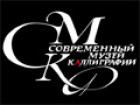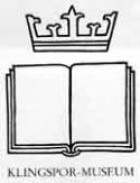Museums of calligraphy
Musée des Lettres et Manuscrits (Museum of Letters and Manuscripts)

The Musée des Lettres et Manuscrits is a museum of letters and manuscripts located at 222 Boulevard Saint-Germain in the 7th arrondissement of Paris, France. It is open daily except Monday; an admission fee is charged. The nearest métro station is Rue du Bac.
The museum was established in 2004 in a townhouse dating to 1608 at 8 Rue de Nesle; it reopened at the Boulevard Saint-Germain location in 2010.
Contemporary Museum of Calligraphy

The Contemporary Museum of Calligraphy’s opening in Moscow turned out to be the most heartwarming cultural event of the year. The Contemporary Museum of Calligraphy is the first museum in Russia, dedicated to the art of handwriting.
Tehran Museum of Contemporary Art

The Museum is one of Iran's finest museums, located in Tehran.
Inaugurated in 1977, and built adjacent to Tehran's Laleh Park, the museum was designed by Iranian architect Kamran Diba, who employed elements from traditional Persian architecture.
Hill Museum Manuscript Library

In the Benedictine tradition of reverence for human thought and creativity, the Hill Museum and Manuscript Library preserves manuscripts, printed books and art at Saint John's University and undertakes photographic projects in regions throughout the world. HMML is the home of the world's largest collection of manuscript images and of The Saint John's Bible, a handwritten, illuminated Bible in modern English. HMML's collections reveal how various cultures express their religious, artistic, and intellectual experience. HMML makes these resources available to students, researchers and visitors through advanced technology for imaging, cataloguing, and teaching.
Sharjah Calligraphy Museum

The Sharjah Calligraphy Museum, the only museum in the Arab world devoted entirely to calligraphy and located in one of the cultural capitals of the Arab world, aims to instil the art of calligraphy in the people and visitors of Sharjah and to set new standards both locally and internationally.
Manuscript Museum (MsM)

The Manuscript Museum (MsM) is one of the academic institutions affiliated to the Library of Alexandria according to Law No. 1 for the year 2001(Article 2) concerning the Library of Alexandria, and according to the presidential decree (no. 269) concerning its establishment. The MsM operates through a number of integrated sections, which work tunefully with the ones in the twin institution; the Manuscript Center (MsC). To harmonize the work flow and fulfill set tasks, units and operations were merged across both institutions into three highly specialized sections in each.
The Karpeles Manuscript Library Museums

The Karpeles Library is the world's largest private holding of important original manuscripts and documents. The archives include Literature, Science, Religion, History and Art. Among the treasures are: The original draft of the Bill of Rights of the United States, The original manuscript of The Wedding March, Einstein's description of his Theory of Relativity, The Thanksgiving Proclamation signed by George Washington, Roget's Thesaurus, Webster's Dictionary and over one million more.
The Museum for calligraphy and small graphics in Pettenbach (Austria)

It is known far beyond the borders of Austria and in 2002 it could celebrate its tenth anniversary: The ”Schrift- und Heimatmuseum“ in Pettenbach, a small community in Upper Austria. What today seems to be the most natural fact of the world, its situation in a small country-village, has a long and very uncommon history.
Naritasan Calligraphy museum

This museum shows works dating from the end of the Edo period up until modern times. Excellent works that is too modern to be thought of as important by some and would therefore be missed, is on display.
The Modern Calligraphy Collection of the National Art Library at the Victoria and Albert Museum, London, England.

The National Art Library at the Victoria and Albert Museum has long had a special interest in calligraphy and lettering. In the nineteenth century it collected all the standard manuals on the subject, from those by the 'Illuminating designer,' Victor Touche, 'The Handbook of Initial Letters' that first came out in 1863, and the works by Digby Wyatt and W.R. Tymms on illumination, to the 'Alphabets Old and New' of Lewis F. Day that appeared in 1898, and Edward Strange's 'Alphabets, a Handbook of Lettering' that went into numerous editions after its initial appearance in 1895. The Library has since collected examples of the illumination and lettering that flourished as an essential ingredient of Victorian decorative art, from an illuminated address of 1877 to the owner of a County Kildare spinning mill from his employees (MSL/1984/69/2), to similar addresses in the form of volumes done by a Liverpool 'Illuminator,' James Orr Marples in 1902 for a retiring chairman of the American Shipping Line (MSL/1983/40), and a presentation to a member of the Ancient Order of Foresters done in 1912 by one Sydney Davis, 'Lithographic writer, draughtsman and illuminator' (MSL/1984/56).
Ditchling Museum

The Ditchling Museum. The hilly landscapes and rural way of life inspired artists including Eric Gill, Edward Johnston, David Jones, and Ethel Mairet to settle in Ditchling in the early years of the 20th Century. The international recognition that followed, as a centre for print, calligraphy, weaving and other crafts, is reflected in the Museum’s permanent collection, and the programme of exhibitions and educational events.
Klingspor Museum

On 7th November 1953 the Klingspor-Museum opened its doors to visitors the first time. During the post-war years the City of Offenbach am Main founded a small museum for the art of modern book production and typography. The basis of the museum was a valuable collection of books of Dr. h.c. Karl Klingspor (1868 - 1950), who together with his brother Wilhelm operated a typefoundry in the first half of the 20th century in Offenbach am Main.
Sakip Sabanci Museum

The Sabanci University Sakip Sabanci Museum is a private fine arts museum in Istanbul, Turkey, dedicated to calligraphic art, religious and state documents, as well as paintings of the Ottoman era. The museum was founded by Sakip Sabanci, and was opened in June 2002. Aside from permanent exhibitions, the museum also hosts national and foreign temporary exhibitions and, hosts cultural events on the weekends.
When there are no words left, the meaning is still preserved.



